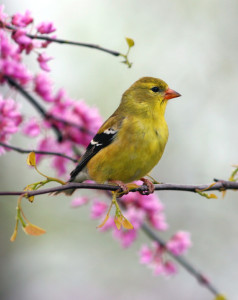Bird Tweet of the Week
Alexander MacDonald, Manager of Protected Areas at Nature Canada has been featured on CBC Radio’s In Town & Out program every Saturday since June.
Check out these “Bird Tweet of the Week” segments which have already aired and stay tuned for this week’s episode.
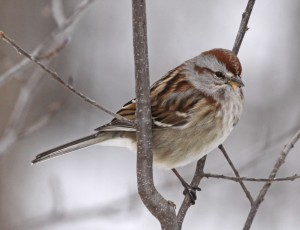
American Tree Sparrow
• American Tree Swallow: aired Saturday March 22, 2014
The American Tree Sparrow is known in French as Bruant hudsonien. From mid-October to early May you can find this species locally in open woodland areas, weedy fields and occasionally at backyard feeders.
• Purple Finch: aired Saturday March 15, 2014
The name “Purple Finch” is somewhat misleading as the males are actually a pink/ red colour. This species is a noisy bird that sometimes will actually add in the sounds of other species such as Barn Swallows, American Goldfinches and Eastern Towhees into their rich warbling song.
• Pine Grosbeak: aired Saturday March 8, 2014
The Pine Grosbeak, also part of the songbird group “winter finches”, is a hardy robin-sized finch that is relatively tame and usually travels in flocks. Their dense feathering allows them to survive the extremely cold winters of the boreal forest.
• Pine Siskin: aired Saturday March 1, 2014
The Pine Siskin, known in French as Tarin des pins, and is notable for its acrobatics, and its high energy and constant twittering. This very winter-hardy species can survive temperatures as low as -70 degrees Celsius, and they actually store significant amounts of seed in their throat crop as an energy reserve to survive cold winter nights.
• Common Redpoll: aired Saturday Feb 22, 2014
The Common Redpoll, known in French as Sizerin flammé, is a member of a group of songbirds known as the “winter finches”. This species is truly winter-hardy and not only do redpolls sometimes roost in long snow burrows at night to stay warm, but they are known to survive ambient temperatures below minus 50 degrees Celsius.
• Black-capped Chickadee: aired Saturday Feb 15, 2014
The Black-capped Chickadee, known in French as Mésange à tête noire, has the impressive ability to grow their brain by 30% in the fall to expand its spatial memory capacity and then shrinks it down to its normal size again in the spring.
• Common Goldeneye: aired Saturday Feb 8, 2014
Common Goldeneyes are silent during the fall until their courtship displays begin from December through April. They are winter visitors to the Ottawa area, especially at the Deschênes Rapids and around large bridges.

Snowy Owl
• Snowy Owl: aired Saturday Feb 1, 2014
Known in French as Harfang des neiges, the Snowy Owl is a diurnal species, which means it will hunt at any hour of the day, unlike most owls. This behaviour is necessary because it spends the summer months to the far north in the Arctic Circle, where there is nearly 24-hours of daylight.
• Red-breasted Nuthatch: aired Saturday Jan 25, 2014
The Red-breasted Nuthatch is a very energetic songbird that, like its cousin, can hang upside-down or sideways while feeding and moves in any direction along tree trunks, including head-first. This species can be quite aggressive toward other larger birds when nesting.
• White-breasted Nuthatch: aired Saturday Jan 18, 2014
The White-breasted Nuthatch, also known in French as Sitelle à poitrine blanche, is one of a small number of bird species in Canada that can hang upside-down or sideways while feeding and can also move down tree trunks head-first.
• Evening Grosbeak: aired Saturday Jan 11, 2014
This species is known in French Gros-bec Errant, it is best described as erratic in its presence and seasonal movements. Some winters the species fans out across the southeast US in a migratory wave while other years they are seldom seen. The Evening Grosbeak is considered quite silent and lacks a definitive song. Instead, it utters a rich, husky chirp similar to a sparrow.
• Dark-eyed Junco: aired Saturday Jan 4, 2014
The Dark-eyed Junco is known in French as Junco ardoisé and when in groups they are known as Quarrels. They are considered one of the most common feeder birds on the continent.
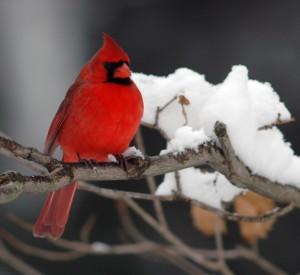
Northern Cardinal
• Northern Cardinal: aired Saturday Dec 21, 2013
The Northern Cardinal, also known in French as Cardinal rouge, is a welcome visitor at any backyard feeder. Both male and female sing up to 20 different songs! Some Cardinal pairs mate for life and they may raise up to 3 broods per summer.
• Common Merganser: aired Saturday Dec 14, 2013
Known in French as Grand Harle and collectively is called ‘sawbills’ given the serrated edges along the insides of their bills. These saw-like edges help mergansers – which are diving duck species – to catch and hold slippery fish and other food they gather during underwater dives.
• Common Loon: aired Saturday Dec 7, 2013
Known in French as Plongeon huard, the Common Loon is an icon of the Canadian wilderness, it’s likeness on our $1 dollar coin and being Ontario’s provincial bird, makes it part of everyday life. Loons are a sign of good water quality given that they require clean, clear waters that hold abundant fish for food.
• Long-tailed Duck: aired Saturday Nov 30, 2013
Known by its former, less politically-correct name “Oldsquaw”, the Long-tailed Duck dives to the greatest depths of any duck – as deep as 60 meters – to feed on aquatic insects, crustaceans, fish and plants.
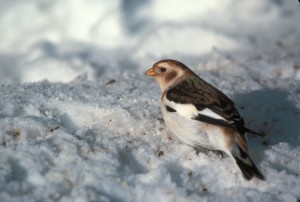
Snow Bunting
• Snow Bunting: aired Saturday Nov 23, 2013
Known collectively as a ‘drift’, snow buntings have the northernmost winter range of any passerine, or perching bird, other than the Common Raven, and they have feathered tarsi, or ankle areas, which help them retain crucial body heat in the cold.
• Brant: aired Saturday Nov 16, 2013
Although the Brant could be considered the doppelgänger of the Canada Goose, Brant fly in a straight line formation.
• Dunlin: aired Saturday Nov 9, 2013
Known collectively as a ‘fling’ of Dunlins, this medium-size sandpiper is a circumpolar breeder that is recognized by birders throughout the northern hemisphere.
• Pileated Woodpecker: aired Saturday Nov 2, 2013
The Pileated Woodpecker is a year-round resident of our region that, despite its size, nests in large cavities it excavates itself in trees – often standing dead trees.
• Peregrine Falcon: aired Saturday Oct 26, 2013
Since being very nearly wiped-out in the 1950s and 60s due to the widespread use of the pesticide DDT, this crow-sized bird has made a dramatic comeback across North America.
• Rusty Blackbird: aired Saturday Oct 19, 2013
As its name suggests, the Rusty Blackbird can be considered rusty in two respects: first because of its metallic song and second because of the rust-coloured plumage of the female and non-breeding males.
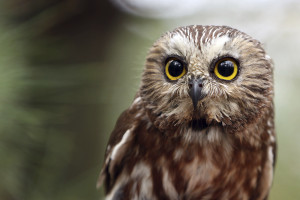
Northern Saw-Whet Owl
• Northern Saw-Whet Owl: aired Saturday Oct 12, 2013
The common name Saw-whet Owl comes from the bird’s whine-like call that sounds like the sharpening, or whetting, of a handsaw blade.
• Yellow-Rumped Warbler: aired Saturday Oct 5, 2013
he species is known for its habit of migrating in large groups that will descend on fruit-bearing bushes in the fall creating a cacophony of chipping sounds and fleeting flashes of yellow.
• Ring-billed Gull: aired Saturday Sept 28, 2013
This is just one of four gulls found locally throughout the year, and this medium sized gull actually migrates.
• Solitary Sandpiper: aired Saturday Sept 21, 2013
This shore bird prefers to migrate along and nests in trees. Two behaviours which set it apart from other shorebirds.
• Common Nighthawk: aired Saturday Sept 14, 2013
The Common Nighthawk is crepuscular, meaning it is active around dusk and dawn. It is a master of camouflage that roosts invisibly by day either on the ground, on a perch or in a tree.
• Purple Martin: aired Saturday Sept 7, 2013
Purple Martins are found locally during migration and breeding between mid-April and early July, and gather in large flocks and move through the region throughout August, vanishing by Labour Day.
• American Goldfinch: aired Saturday Aug 31, 2013
At the feeder, Goldfinches are noisy and boisterous, and always appear to be squabbling with each other.
• Great Egret: aired Saturday Aug 24, 2013
the call of this stark white bird brings to mind a dinosaur. You won’t likely hear it unless the birds are in courtship, on the nest or startled
• Cedar Waxwing: aired Saturday Aug 17, 2013
Local observations of this species occur year-round but peak from early June before dropping-off in mid-September. Look for waxwings feasting on Sumac berries during the winter months.
• Red-Eyed Vireo: aired Saturday Aug 10, 2013
The song of the Red-Eyed Vireo has an intonation which makes it sound like a series of questions and answers.
• Hermit Thrush: aired Saturday Aug 3, 2013
Hermit Thrushes breed in our region in all forest types, where their nests are located low in vegetation or on the ground. They can often be spotted or heard near clearings or along trails in wooded areas, but don’t expect them to visit your feeder. They feed on insects on the forest floor and in vegetation using their feet to rummage through leaf litter.
• House Finch: aired Saturday July 27, 2013
House Finches now thrive in our yards, parks and urban centres. They nest in all types of trees, and even in building vents and hanging planters. You’ll see or hear them calling year-round from tall trees and hydro-lines.
• Common Grackle: aired Saturday July 20, 2013
A “plague” of grackles might be mistaken for crows, but look closely, these birds are actually iridescent with a purple/blue-green sheen to their heads and bronzy iridescent bodies.
• Bobolink: aired Saturday July 13, 2013
When was the last time you heard the Star Wars robot R2-D2 in a field? What you actually heard was probably a singing male Bobolink.
• Chimney Swift: aired Saturday July 6, 2013
You will rarely see a Chimney Swift except in flight since they can’t perch like other birds. Instead they use long claws to cling to vertical surfaces, including the insides of chimneys and air ducts where they nest and roost, which is where they get their name.
• White-throated Sparrow: aired Saturday June 29, 2013
Celebrate Canada Day with the White-throated Sparrow. Its song is a clear, slightly wavering whistle that sounds like “Oh sweeeet Canada Canada Canada”.
The Lac Deschénes – Ottawa River Important Bird Area Program is lead by Nature Canada as the Canadian co-partner for Bird Life International along with our local partners the Ottawa Field Naturalists Club and club des ornithologues de l’outaouais.

